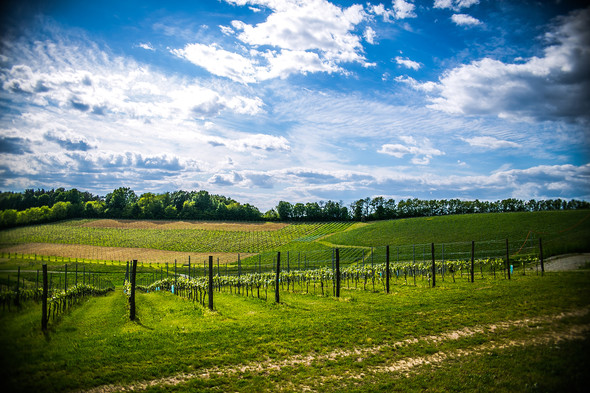Similar to Burgundy and Mediterranean wines, let’s establish a distinct category of Pannonian or Carpathian Basin wine.
Roland Velich, born into a winemaking family, had studied Law, Political Science and Philosophy at university and after working ten years as a croupier, he started to build his own winery in Großhöflein next to Neusiedlersee. The estate was named Moric in homage to his Austro-Hungarian roots.
Around the turn of the century, I felt the time was right to quit the family winery and by then I’d already been interested in Blaufränkish for some time. This variety originates from our region and it isn’t there by chance, but because it has proven itself over centuries. And here, I should mention what I consider good wine. When I started getting interested in wine at the beginning of the 80s, I wanted to know what wines the world held in high regard. I went to Bordeaux, Burgundy and Piedmont. I found that, especially in Burgundy, they are truly small wineries who work with their own varieties. That’s exactly what I saw in Blaufränkish: this is ours and I tried to work with it using the same care: old vines, low yields and minimal intervention. We started MORIC in 2001 based on these principles.
His wines from the Lutzmannsburg and Neckenmarkt ridges have made wines from Burgenland well-known all over the world, along with Blaufränkish itself. The wines of this Austrian star winemaker are distributed in Hungary by Bortársaság, which has recently conducted an extensive interview with him, in which Mr Velich formulates remarkable ideas that may be significant for the future of winemaking in the Carpathian Basin.
The Pannonian region is characterised by a long, warm autumn which is perfect for Blaufränkish. Besides a balanced yield, perfect phenolic ripeness can be achieved – and this is important, since if it doesn’t ripen completely, Blaufränkish is unpleasantly green. However, our wines are fresh, fruity, and make you want to have another mouthful.
The majority of wine is produced in warm climates and this offers us an advantage. Many wine regions simply cannot produce sophisticated and elegant wines. Our wines, on the other hand, are fresh and fruity, making you want another sip.
I’m greatly interested in Burgenland’s sociological and political history. 150 years ago the region was an important centre of the Hungarian winemaking world. If you wish to determine the kind of wine you want to make in the future, first you have to look back and see what history shows you and then you can head in the right direction towards the future. We were so much connected, there are so many things linking us to one another. The varieties, the soil, the climate. We belong under the same vinicultural concept. Just as there is a concept for Burgundy or Mediterranean wine, there should be one for Carpathian Basin or Pannonian wine. This is our heritage that we should embrace and forget about country borders.
I totally agree with these words. I often feel that there is a kind of disease among Central European winemakers, which makes us want to produce grand wines from world famous varieties. However, as Mr Velich also put it, if we have our own varieties, let’s use those, become their masters and introduce them to the world. Mind you, I’m not suggesting that we should stop producing top varieties, only that the proportions should be changed.
When analysing it from the consumers’ side, it is clear that Central European countries sell 80% of their own wines within their borders, while the international market is not seeking yet another Chardonnay or Bordeaux blend. Increasingly knowledgeable wine-consumers are searching for novelties and – taking into account that wine is the most popular drink in the world – it is certainly worth planning for the long run.
We should also mention that it is hopeless to wage ‘war’ against Tuscany when this one Italian area is in itself as large as the total area of wine-producing regions of Hungary. This also leads us to the second most significant problem: it is true in all Central European countries that we simply cannot produce a large enough quantity for the whole world. Let us toy with the idea and imagine that the long-awaited Pannonian or Carpathian Basin region is created; we could not only present new wines using our own varieties, but together we could make a sufficient amount for a large European, American or Asian market. Obviously, this would involve a lot, ranging from quality assurance to the foundation of a supervisory and marketing organisation, to say the least.
Autochthon grape varieties are the future, though I must admit that this is the hard way. There is a lot of planting and learning to do, they need to be introduced to the market and popularised. I believe Mr Velich and Blaufränkish offer a fine example.
Finally, let me list some grape varieties I consider worthy of similar success in the international market. Based on their current reputation, I am highlighting the names I would recommend using according to a homogenous naming convention.
- Blaufränkisch (Kékfrankos, Frankovka, Modra Frankinja, Franconia, Gamé)
- Cserszegi fűszeres
- Fetească albă (Păsărească, Vărătic, Leányka, Mädchentraube)
- Fetească neagră (Coada Randunicii, Fekete Leányka, Mädchentraube Schwarz)
- Furmint (Šipon, Mosler, Moslovac, Posipel, Zopfner, Tokay)
- Graševina (Welschriesling, Olaszrizling, Laški Rizling, Ryzlink vlašský, Riesling Italico)
- Irsai Olivér (Irsai, Oliver Irsay, Zolotistyj Rannij, Muscat Oliver)
Naturally, the list goes on because we have many unique grape varieties. Once the distinct category is in people’s minds, that in itself will count as a real success.






